Chapters
- Getting Started with Groovy
- Installing Groovy on Windows
- Installing Groovy on Linux
- Executing Groovy code from the command-line
- Using Groovy as a command-line text file editor
- Using Groovy to start server on the command-line
- Running Groovy with invokedynamic support
- Building Groovy from source
- Installing Groovy on Linux
- Using groovysh to try out Groovy commands
- Starting groovyConsole to execute Groovy snippets
- Configuring Groovy in Eclipse
- Configuring Groovy in IntelliJ IDEA
- Using Groovy Ecosystem
- Using Java classes from Groovy
- Embedding Groovy into Java
- Compiling Groovy code
- Simplifying dependencies management with Grape
- Integrating Groovy into build process using Ant
- Integrating Groovy into build process using Maven
- Integrating Groovy into build process using Gradle
- Generating documentation for Groovy code
- Checking Groovy code quality with CodeNarc
- Using Groovy Language Features
- Searching strings with regular expressions
- Writing less verbose Java Beans with Groovy Beansa
- Inheriting constructors in Groovy classes
- Adding cloning functionality to Groovy Beans
- Defining code as data in Groovy
- Defining data structures as code in Groovy
- Implementing multiple inheritance in Groovy
- Adding functionality to existing Java/Groovy classes
- Defining type checking rules for dynamic code
- Adding automatic logging to Groovy classes
- Working with Files in Groovy
- Reading from a file
- Reading a text file line by line
- Processing every word in a text file
- Writing to a file
- Replacing tabs with spaces in a text file
- Filtering a text file content
- Deleting a file or directory
- Walking through a directory recursively
- Searching for files
- Changing file attributes on Windows
- Reading data from a ZIP file
- Reading an Excel file
- Extracting data from a PDF
- Working with XML in Groovy
- Reading XML using XmlSlurper
- Reading XML using XmlParser
- Reading XML content with namespaces
- Searching in XML with GPath
- Searching in XML with XPath
- Constructing XML content
- Modifying XML content
- Sorting XML nodes
- Serializing Groovy Beans to XML
- Working with JSON in Groovy
- Parsing JSON messages with JsonSlurper
- Constructing JSON messages with JsonBuilder
- Modifying JSON messages
- Validating JSON messages
- Converting JSON message to XML
- Converting JSON message to Groovy Bean
- Using JSON to configure your scripts
- Working with Databases in Groovy
- Creating a database table
- Connecting to an SQL database
- Querying an SQL database
- Modifying data in an SQL database
- Calling a stored procedure
- Reading BLOB/CLOB from a database
- Building a simple ORM framework
- Using Groovy to access Redis
- Using Groovy to access MongoDB
- Using Groovy to access Apache Cassandra
- Working with Web Services in Groovy
- Downloading content from the Internet
- Executing an HTTP GET request
- Executing an HTTP POST request
- Constructing and modifying complex URLs
- Issuing a REST request and parsing a response
- Issuing a SOAP request and parsing a response
- Consuming RSS and ATOM feeds
- Using basic authentication for web service security
- Using OAuth for web service security
- Metaprogramming and DSLs in Groovy
- Querying methods and properties
- Dynamically extending classes with new methods
- Overriding methods dynamically
- Adding performance logging to methods
- Adding caching functionality around methods
- Adding transparent imports to a script
- DSL for executing commands over SSH
- DSL for generating reports from log files
- Concurrent Programming with Groovy
- Processing collections concurrently
- Downloading files concurrently
- Splitting a large task into smaller parallel jobs
- Running tasks in parallel and asynchronously
- Using actors to build message-based concurrency
- Using STM to atomically update fields
- Using dataflow variables for lazy evaluation
- Testing with Groovy
- Unit testing Java code with Groovy
- Testing SOAP web services
- Testing RESTful services
- Writing functional tests for web applications
- Writing behavior-driven tests with Groovy
- Testing the database with Groovy
- Using Groovy in soapUI
- Using JMeter and Groovy for load testing
Cross-References
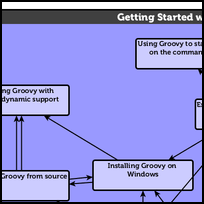 Chapter 1. Getting Started with Groovy
Chapter 1. Getting Started with Groovy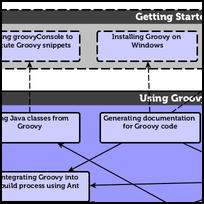 Chapter 2. Using Groovy Ecosystem
Chapter 2. Using Groovy Ecosystem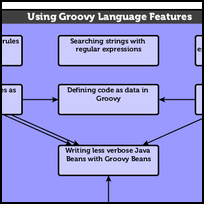 Chapter 3. Using Groovy Language Features
Chapter 3. Using Groovy Language Features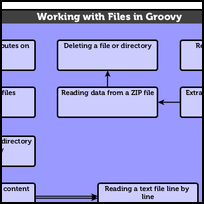 Chapter 4. Working with Files in Groovy
Chapter 4. Working with Files in Groovy Chapter 5. Working with XML in Groovy
Chapter 5. Working with XML in Groovy Chapter 6. Working with JSON in Groovy
Chapter 6. Working with JSON in Groovy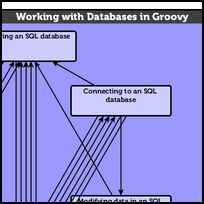 Chapter 7. Working with Databases in Groovy
Chapter 7. Working with Databases in Groovy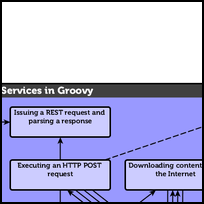 Chapter 8. Working with Web Services in Groovy
Chapter 8. Working with Web Services in Groovy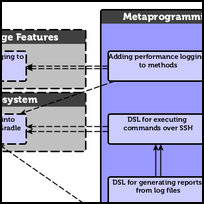 Chapter 9. Metaprogramming and DSLs in Groovy
Chapter 9. Metaprogramming and DSLs in Groovy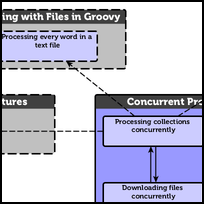 Chapter 10. Concurrent Programming with Groovy
Chapter 10. Concurrent Programming with Groovy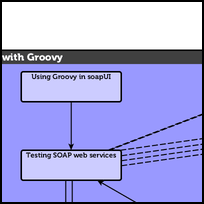 Chapter 11. Testing with Groovy
Chapter 11. Testing with Groovy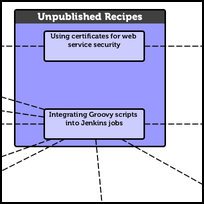 Chapter 12. Unpublished Recipes
Chapter 12. Unpublished Recipes

